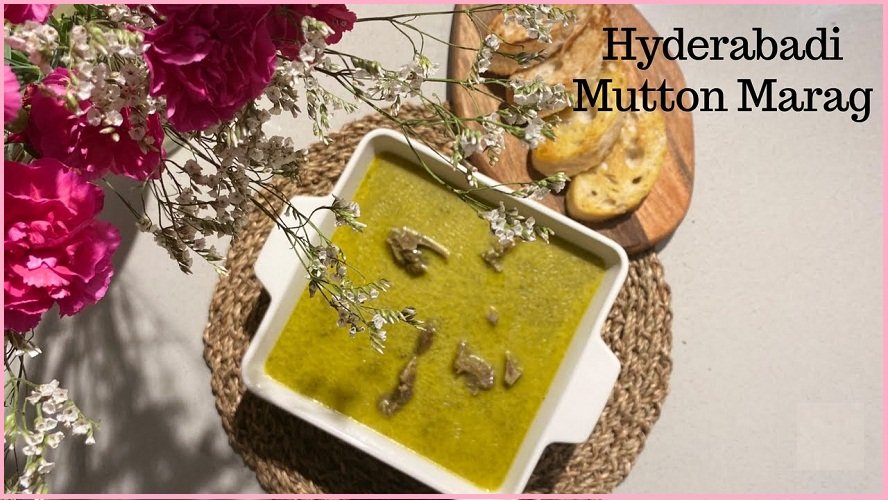
Perfecting Delicious Hyderabadi Marag
Mastering the Art of Hyderabadi Marag: A Step-by-Step Guide
Hyderabadi Marag is a rich and flavorful soup that hails from the royal kitchens of Hyderabad, India. This delectable dish, often served as a starter at weddings and special occasions, is known for its tender meat and aromatic spices. If you’ve ever wanted to learn how to make Hyderabadi Marag at home, this comprehensive guide will walk you through each step, ensuring a perfect result every time.
Chapter 1: Introduction to Hyderabadi Marag
Hyderabadi Marag is a traditional meat soup that is both nourishing and delicious. It is usually made with tender mutton, but can also be prepared with chicken. The dish is characterized by its use of aromatic spices, fresh herbs, and a creamy texture that comes from slow cooking.
Chapter 2: Ingredients Required
To make Hyderabadi Marag, you will need the following ingredients:
500 grams of mutton (preferably with bones)
2 large onions, finely sliced
2 tablespoons of ginger-garlic paste
2-3 green chilies, slit
1 cup of yogurt
1/2 cup of fresh cream
1 teaspoon of black pepper powder
1 teaspoon of garam masala
1 teaspoon of cumin powder
1 teaspoon of coriander powder
1/2 teaspoon of turmeric powder
2-3 cloves
2-3 cardamom pods
1 cinnamon stick
Salt to taste
Fresh coriander leaves for garnish
2 tablespoons of ghee or oil
Chapter 3: Preparing the Mutton
Cleaning the Mutton: Wash the mutton pieces thoroughly under running water. Remove the water and place the mutton to the side. Marinating: In a bowl, mix the mutton with yogurt, half of the ginger-garlic paste, and a pinch of salt Allow it to marinate for a minimum of one hour. Mari nation aids in tenderizing the meat and imparting flavor into it.
Chapter 4: Sautéing the Aromatics
Heating the Ghee: In a large pot, heat the ghee or oil over medium heat.
Adding Whole Spices: Add the cloves, cardamom pods, and cinnamon stick. Sauté until they release their aroma.
Sautéing Onions: Add the finely sliced onions to the pot. Cook until they turn golden brown, stirring occasionally to prevent burning.
Chapter 5: Cooking the Mutton
Adding Ginger-Garlic Paste: Add the remaining ginger-garlic paste to the pot and sauté for a few minutes.
Adding Green Chilies: Add the slit green chilies and stir well.
Adding Mutton: Add the marinated mutton pieces to the pot. Cook until the mutton is evenly browned on all surfaces.

Chapter 6: Spicing it up
Adding Spice Powders: Add the black pepper powder, garam masala, cumin powder, coriander powder, and turmeric powder. Mix thoroughly to ensure the mutton is evenly coated with the spices.
Cooking with Water: Add enough water to cover the mutton pieces. Bring it to a boil, then reduce the heat to low and let it simmer for about 45 minutes to an hour, or until the mutton is tender.
Chapter 7: Finishing Touches
Adding Fresh Cream: Stir in the fresh cream and let it cook for another 5-10 minutes.
Adjusting Seasoning: Taste the soup and adjust the salt and spices if needed.
Garnishing: Garnish with fresh coriander leaves.
Chapter 8: Serving Suggestions
Hyderabadi Marag is best served hot, with a side of naan, roti, or steamed rice. It can also be savored on its own as a soup.
Chapter 9: Tips and Tricks
Choosing the Meat: For the best results, use tender cuts of mutton with bones. The bones add depth to the flavor of the soup.
Slow Cooking: Slow cooking is key to achieving the perfect texture and flavor. Don’t rush the process.
Balancing Spices: Adjust the spice levels according to your taste preference. If you prefer a milder soup, reduce the amount of green chilies and black pepper.
Chapter 10: Conclusion
Making Hyderabadi Marag at home might seem daunting at first, but with this step-by-step guide, you’ll find it easier than ever. The rich flavors and tender meat make this dish a true delight. Whether you’re cooking for a special occasion or simply want to enjoy a comforting bowl of soup, Hyderabadi Marag is sure to impress.
Chapter 11: Variations of Hyderabadi Marag
While the traditional Hyderabadi Marag recipe is a classic, there are several variations you can try to suit different tastes and preferences.
Chicken Marag: Substitute the mutton with chicken for a lighter version of the soup. Follow the same steps, but reduce the cooking time since chicken cooks faster than mutton.
Vegetarian Marag: For a vegetarian version, use vegetables like carrots, potatoes, and cauliflower. Add a rich vegetable broth to enhance the flavor.
Spicy Marag: If you enjoy a spicier dish, increase the amount of green chilies and black pepper. You can also add a pinch of red chili powder for extra heat.
Creamier Marag: For a richer, creamier texture, increase the amount of fresh cream and yogurt in the recipe.
Chapter 12: Pairing Hyderabadi Marag with Other Dishes
Hyderabadi Marag pairs wonderfully with a variety of side dishes and accompaniments:
Naan or Roti: Serve with freshly baked naan or roti to soak up the flavorful soup.
Steamed Rice: A simple bowl of steamed basmati rice complements the rich marag perfectly.
Biryani: For a royal feast, pair Hyderabadi Marag with a plate of fragrant Hyderabadi Biryani.
Kebabs: Add some kebabs to your meal for an extra layer of flavor and texture.
Chapter 13: Nutritional Benefits of Hyderabadi Marag
Hyderabadi Marag is not only delicious but also nutritious:
Protein-Rich: The mutton provides a good source of protein, essential for muscle repair and growth.
Bone Health: The bones in the mutton add calcium and other minerals to the soup, promoting healthy bones.
Spices: The spices used in marag, such as turmeric and black pepper, have anti-inflammatory and antioxidant properties.
Digestive Aid: The ginger and garlic in the recipe aid in digestion and boost immunity

Chapter 14: Frequently Asked Questions
Can I make Hyderabadi Marag ahead of time?
Yes, you can make the marag ahead of time and reheat it before serving. In fact, In fact, it often develops a richer flavor the following day as the flavors blend together more.
What can I substitute for fresh cream?
If you prefer a lighter version, you can use coconut milk or cashew cream as a substitute for fresh cream.
Is Hyderabadi Marag gluten-free?
Yes, Hyderabadi Marag is naturally gluten-free. Just ensure that the spices and other ingredients you use do not contain any hidden gluten.
Chapter 15: Troubleshooting Common Issues
Marag is too spicy: If your marag turns out too spicy, add more fresh cream or yogurt to balance the heat.
Meat is not tender: Ensure you cook the meat long enough. If it’s still tough, let it simmer for a bit longer until it reaches the desired tenderness.
Soup is too thick: Add more water or broth to reach the consistency you prefer.
Chapter 16: Storing and Reheating Hyderabadi Marag
Storing: Store any leftover marag in an airtight container in the refrigerator for up to 3 days.
Freezing: For longer storage, you can freeze the marag. Allow it to cool completely before transferring it to a freezer-safe container. It can be stored in the freezer for up to 3 months.
Top of Form
Bottom of Form
Reheating: Reheat the marag on the stovetop over low heat, stirring occasionally until heated through. You may need to add a bit of water or broth if it has thickened too much.
Chapter 17: Serving Hyderabadi Marag at Parties
Hyderabadi Marag is an excellent dish to serve at parties and gatherings. Here are some tips for presenting it beautifully:
Garnish Generously: Garnish with freshly chopped coriander leaves and a drizzle of fresh cream for a luxurious look.
Serve with Accompaniments: Offer a variety of sides like naan, rice, and salad so guests can enjoy a complete meal.
Use Elegant Tableware: Serve the marag in elegant bowls or soup tureens to enhance the dining experience.
Chapter 18: Exploring Hyderabadi Cuisine
Hyderabadi Marag is just one gem in the rich tapestry of Hyderabadi cuisine. Here are a few other dishes you might want to try:
Hyderabadi Biryani: A fragrant and flavorful rice dish with layers of marinated meat and aromatic rice.
Mirchi ka Salan: A spicy and tangy curry made with green chilies, peanuts, and tamarind.
Double ka Meetha: A sweet bread pudding made with fried bread slices, milk, and sugar, garnished with nuts and saffron.
Chapter 19: Cooking Hyderabadi Marag for Special Diets
Low-Fat Version: Use lean cuts of meat and reduce the amount of cream for a lower-fat version of the marag.
Keto-Friendly: Ensure the ingredients you use are keto-friendly, focusing on high-fat dairy and avoiding any high-carb additions.
Paleo: Use coconut milk or almond milk instead of dairy, and ensure the spices and other ingredients are compliant with the paleo diet.
Chapter 20: Final Thoughts and Encouragement
Making Hyderabadi Marag is a rewarding experience that allows you to bring a piece of Hyderabadi heritage into your kitchen. The process is not only about cooking but also about immersing yourself in the rich culture and history of Hyderabad. Don’t be afraid to experiment with the recipe and make it your own. With practice and patience, you’ll master this delightful dish and impress your family and friends with your culinary skills.
Enjoy the journey of making Hyderabadi Marag, and relish every spoonful of this aromatic and flavorful soup!










